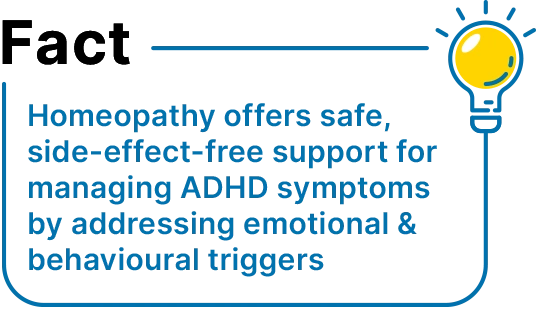ADHD Homeopathic Treatment
Homeopathy for ADHD: A Natural Way to Nurture Young Minds
Book your Appointment
Attention-deficit hyperactivity disorder (ADHD) is more than just restlessness or distraction. It affects a child’s ability to focus, behave, and learn. While conventional medications often manage symptoms, they may come with side effects or long-term dependency. That’s where homeopathy provides a gentle, holistic, and non-addictive alternative.
At Dr Batra’s®, we offer personalised ADHD homeopathic treatment that focuses on your child’s unique symptoms and temperament. With over 350 expert homeopaths across 200+ clinics in 7 countries, we aim to restore balance gently and naturally.
At Dr Batra’s®, we understand how overwhelming it is for parents when their child struggles with attention and behavior. Our treatment plan is tailor-made based on a complete evaluation of your child’s emotional, physical, and behavioral health.
Personalised care
Every ADHD case is different. Our experts create customised treatment plans based on the child's unique symptoms and temperament.
Safe and non-addictive
No risk of drug dependency or harmful side effects.
Holistic support
Addresses both behavioral and physical symptoms like restlessness, irritability, allergies, or digestive issues.
Long-term results
Aims to reduce hyperactivity and improve focus, learning ability, and emotional balance
Trusted expertise
Backed by 40+ years of clinical experience in treating children with sensitivity and compassion
Measurable Outcomes
Our treatment outcome report ensures transparency and patient progress through doctor observations, photographs and investigation findings.
Children with ADHD may show different symptoms, which include:
Difficulty paying attention or staying focuse
Impulsive behavior or acting without thinking
Constant fidgeting, running, or climbing
Trouble following instructions or completing tasks
Talking excessively or interrupting others
Frequent mood swings or frustration
A study published on PubMed found that homeopathy helped 83 children with ADHD gain better focus, fewer impulse issues, and longer attention spans, with no side effects reported
While the exact cause is unknown, common contributors include:
Genetic factors or family history of ADHD
Premature birth or low birth weight
Brain injury or development issues
Exposure to toxins like lead during early childhood
Poor diet or nutritional imbalances
High screen time or lack of outdoor play
Smoking and alcohol during pregnancy
Homeopathic treatment focuses on identifying the root causes and patterns of behavior. By stimulating the body’s own healing mechanisms, homeopathy helps in:
Regulating hyperactivity
Improving attention span and memory
Reducing impulsive actions
Enhancing mood and sleep
Supporting brain and gut health for metabolic balance
Our treatment outcome report ensures transparency and patient progress through doctor observations, photographs and investigation findings.
It’s completely safe, side-effect-free, and suitable even for children below 6 years of age.
| Feature | Conventional Treatment | Homeopathy |
|---|---|---|
| Approach | ||
| Side Effects | ||
| Long-Term Relief | ||
| Personalisation | ||
| Emotional Balance |
While treatment is always individualised, some commonly prescribed remedies include:

These medicines should only be taken under the supervision of a qualified homeopath.
Homeopathy works best when supported by mindful parenting and routine care:
Maintain a consistent daily routine
Limit processed sugar and artificial food colors
Encourage outdoor play and physical activity
Limit screen time and promote reading or puzzles
Provide calm and structured environments
Homeopathy works best when supported by mindful parenting and routine care:
Over 350 expert homeopaths
200+ clinics in 7 countries
40+ years of clinical excellence
Safe, gentle, and personalised care
Thousands of children treated successfully with long-term results

Yes, homeopathic treatment is completely safe and non-addictive. It works gently and is tailored to your child’s individual needs.
Results vary, but many parents see improvement in behavior, focus, and hyper activity levels within a few months of consistent treatment.
Yes. Homeopathy can be an effective alternative for managing ADHD symptoms without the risk of side effects or dependency.
Absolutely. We combine medical care with lifestyle advice, behavioral counselling, and parental guidance for holistic ADHD support.